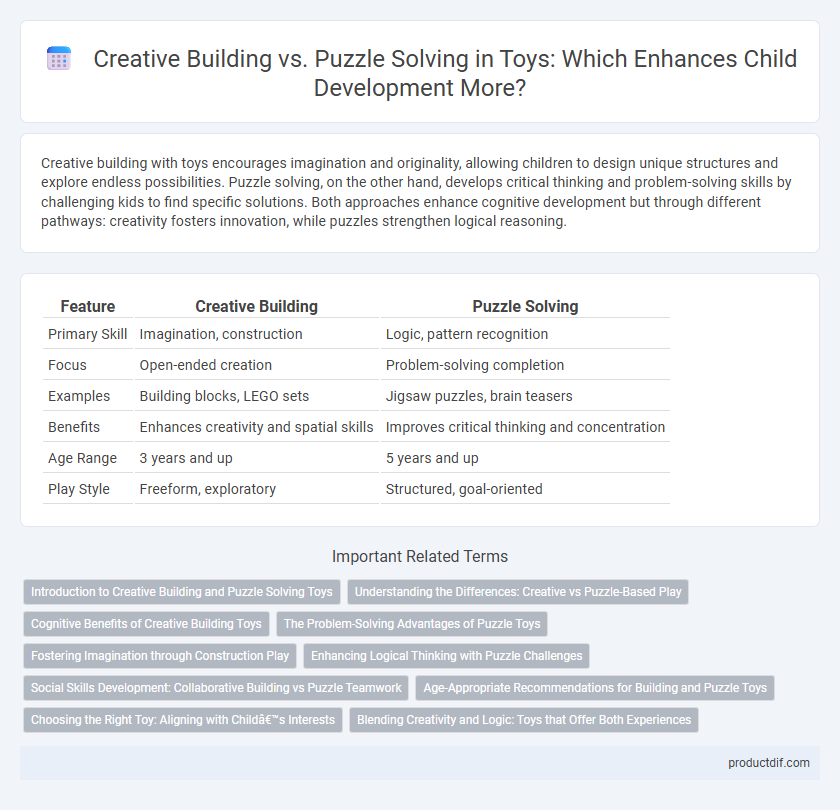Creative building with toys encourages imagination and originality, allowing children to design unique structures and explore endless possibilities. Puzzle solving, on the other hand, develops critical thinking and problem-solving skills by challenging kids to find specific solutions. Both approaches enhance cognitive development but through different pathways: creativity fosters innovation, while puzzles strengthen logical reasoning.
Table of Comparison
| Feature | Creative Building | Puzzle Solving |
|---|---|---|
| Primary Skill | Imagination, construction | Logic, pattern recognition |
| Focus | Open-ended creation | Problem-solving completion |
| Examples | Building blocks, LEGO sets | Jigsaw puzzles, brain teasers |
| Benefits | Enhances creativity and spatial skills | Improves critical thinking and concentration |
| Age Range | 3 years and up | 5 years and up |
| Play Style | Freeform, exploratory | Structured, goal-oriented |
Introduction to Creative Building and Puzzle Solving Toys
Creative building toys foster imagination and spatial skills by allowing children to construct unique structures and designs using versatile components like blocks or connectors. Puzzle solving toys enhance critical thinking and problem-solving abilities by challenging players to identify patterns, decode sequences, or complete intricate assemblies. Both toy types support cognitive development, fine motor skills, and perseverance through hands-on, engaging play experiences.
Understanding the Differences: Creative vs Puzzle-Based Play
Creative building toys encourage open-ended exploration, allowing children to design unique structures and express individual creativity through various shapes and colors. Puzzle-based play emphasizes problem-solving skills by requiring players to complete specific patterns or challenges, fostering logical thinking and spatial reasoning. Understanding these differences helps parents select toys that target either imaginative development or cognitive skill enhancement in children.
Cognitive Benefits of Creative Building Toys
Creative building toys enhance spatial reasoning, fine motor skills, and problem-solving abilities by encouraging open-ended exploration and imaginative play. Unlike puzzle solving, which typically follows a set pattern or solution, building toys stimulate divergent thinking and foster innovation through trial and error. Engaging with these toys supports brain development by promoting executive functions such as planning, flexible thinking, and working memory.
The Problem-Solving Advantages of Puzzle Toys
Puzzle toys enhance cognitive development by encouraging critical thinking, spatial reasoning, and pattern recognition. These toys engage children in hands-on problem-solving, improving memory retention and enhancing fine motor skills. Research shows that interactive puzzle play fosters perseverance and boosts analytical abilities, making it a crucial tool in educational development.
Fostering Imagination through Construction Play
Creative building toys encourage open-ended exploration that stimulates spatial reasoning and inventive thinking, unlike traditional puzzles which emphasize problem-solving and pattern recognition. Construction play fosters imagination by allowing children to design unique structures, promoting cognitive flexibility and fine motor skills development. Engaging with building sets such as LEGO or magnetic blocks enhances creative expression while supporting STEM learning principles.
Enhancing Logical Thinking with Puzzle Challenges
Creative building toys engage children in open-ended construction, fostering imaginative problem-solving skills and spatial reasoning. Puzzle challenges enhance logical thinking by requiring pattern recognition, sequential analysis, and strategy development. Combining both approaches supports cognitive growth through hands-on learning and critical thinking exercises.
Social Skills Development: Collaborative Building vs Puzzle Teamwork
Creative building toys foster social skills by encouraging collaborative construction, where children share ideas, communicate effectively, and negotiate roles. Puzzle-solving activities enhance teamwork through collective problem-solving, promoting patience, turn-taking, and mutual support. Both approaches develop essential interpersonal skills but emphasize different aspects of social interaction.
Age-Appropriate Recommendations for Building and Puzzle Toys
Creative building toys develop spatial reasoning and fine motor skills for children aged 3 to 10, with blocks, LEGO sets, and magnetic tiles being ideal for these stages. Puzzle toys, such as jigsaw puzzles and logic games, enhance problem-solving abilities and memory in ages 5 to 12, with complexity gradually increasing to match cognitive growth. Selecting age-appropriate building and puzzle toys ensures optimal developmental benefits while maintaining engagement and safety.
Choosing the Right Toy: Aligning with Child’s Interests
Choosing toys that match a child's interests enhances engagement and skill development by balancing creative building sets, which foster imagination and problem-solving, with puzzle-solving toys that improve logical thinking and spatial awareness. Understanding whether a child prefers open-ended creativity or structured challenges allows caregivers to select toys that stimulate their cognitive growth effectively. Prioritizing toys aligned with the child's natural preferences leads to increased enjoyment and sustained learning motivation.
Blending Creativity and Logic: Toys that Offer Both Experiences
Creative building toys like LEGO and magnetic blocks stimulate imaginative design and spatial reasoning, allowing children to construct unique structures. Puzzle-solving toys such as Rubik's Cubes and brain teasers enhance critical thinking and pattern recognition skills through logical challenges. Toys that blend creativity and logic, like modular robotics kits and 3D puzzle sets, foster both artistic expression and cognitive development, promoting well-rounded play experiences.
Creative building vs puzzle solving Infographic

 productdif.com
productdif.com